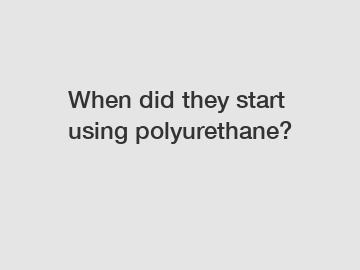When did they start using polyurethane?
Polyurethane is a versatile material that has many applications, from insulation to furniture to footwear. But when did they start using polyurethane? To answer this question, we need to take a closer look at the history of this innovative material and discover how it has evolved over the years.
**Early Developments**.
The development of polyurethane can be traced back to the early 20th century, with researchers exploring the properties of various polymers and chemicals. In the 1930s, German chemist Otto Bayer and his team made a groundbreaking discovery that would lead to the creation of polyurethane. By reacting diisocyanates with polyols, they were able to produce a material that was both strong and flexible.

**Industrial Applications**.
The first industrial applications of polyurethane came in the 1940s, during World War II. Polyurethane foam was used as a replacement for natural rubber, which was in short supply due to the war. This foam was used in a variety of military applications, including insulation for aircraft and as a coating for fuel tanks.
**Commercial Use**.
After the war, polyurethane continued to gain popularity in commercial applications. In the 1950s, companies began using polyurethane foam in upholstery and mattresses. This foam provided a comfortable and durable alternative to traditional materials, leading to its widespread adoption in the furniture industry.
**Further Developments**.
Throughout the second half of the 20th century, researchers made significant advancements in the field of polyurethane chemistry. They experimented with different formulations and techniques, leading to the creation of new types of polyurethane with a wide range of properties. These developments allowed polyurethane to be used in an even greater variety of applications, from automotive parts to adhesives to clothing.
**Modern Uses**.
Today, polyurethane is one of the most widely used materials in the world. It can be found in almost every industry, from construction to electronics to healthcare. Polyurethane foam is used in insulation to improve energy efficiency, while polyurethane coatings protect surfaces from corrosion and wear. In the automotive industry, polyurethane is used in everything from seats to bumpers to dashboards.
**Future Trends**.
As technology continues to advance, researchers are constantly exploring new ways to use polyurethane. For example, there is growing interest in the development of bio-based polyurethanes, which are made from renewable resources such as plant oils. These environmentally friendly materials could help reduce the carbon footprint of the polyurethane industry and lead to a more sustainable future.
In conclusion, polyurethane has come a long way since its discovery in the early 20th century. From its humble beginnings as a wartime substitute for rubber to its current status as a ubiquitous material in modern industry, polyurethane has proven to be a versatile and essential material. As researchers continue to push the boundaries of what is possible with polyurethane, we can expect to see even more innovative applications in the years to come.
If you have any questions about polyurethane or would like to learn more about its uses, please feel free to contact us.
Contact us to discuss your requirements of blue adhesive plastic film, removing protective film from stainless steel, Electrical Insulation Wrapping Film. Our experienced sales team can help you identify the options that best suit your needs.


